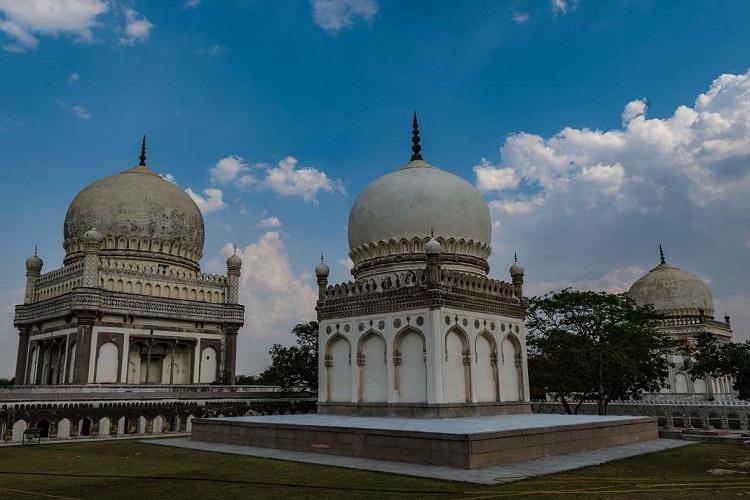By Pallavi Laxmikanth
Hyderabad: Pineapples are originally native to the lowlands of South America and were claimed to be ‘discovered’ by Christopher Columbus in the Caribbean in 1493. They were brought to India by the Portuguese when Goa was colonised in 1510, and it eventually reached other places here.
For the Deccan Sultans, like the Qutb Shahis of the Golconda dynasty (1518-1687), the pineapple was an important symbol of wealth, hospitality and abundance. One can find pineapple motifs on the Charminar, and its design elements on almost every Qutb Shahi or Golconda era tomb.

In his seminal work, The Historical Companion to Indian Food, K T Achaya details its appearance in Indian history. The fruit is first known to be described in India in 1564, nearly a hundred years before it was seen in England, noted both in the Ain i Akbari (a 16th century document detailing the administration of emperor Akbar) and accounts from Mughal emperor Jahangir’s reign for its expensiveness – the price for 1 pineapple was equivalent to that of 10 mangoes!
For residents of the Deccan, and those familiar with its history, the pineapple is a common architectural and design motif, typically adorning tombs and other monuments. In fact, the tomb of Sultan Abdullah Qutb Shah, the sixth Golconda king, has doorways adorned with pineapple motifs.
How did a fruit of Portuguese prestige turn into a Deccani symbol of wealth and hospitality?
The History
While pineapples easily grew in tropical climates, they were much harder to grow in colder, European climates. Driven by the demands for sweet pineapple pleasures among the European elite, the Dutch first took up the challenges of grafting it in greenhouses in the Netherlands (O’Connor 2013).
There was limited success with these experiments and pineapple consumption continued exclusively through imports – which only the wealthy could afford. Its relative scarcity and price quickly made it a status symbol of wealth among the Spanish, Dutch and Portuguese elite.
Pineapples would decorate dining tables and would be carried around to be ‘shown off’ by families. Recently featured in the hit Netflix show Bridgerton, which is set to Victorian England, one may notice the pineapple delicately placed like a crown jewel, adorning the banquet tables of the English aristocracy.
On social occasions, dilemmas would often arise – should it be cut and served or displayed for everyone to see?
Goa, with its tropical climate and rich soil, was fertile ground for the pineapple plantation economy. When the Portuguese took over Goa from the Bijapur Sultan Yusuf Adil Shah, processes of cultural exchange in the new reign resulted in pineapples rising in importance also among the Deccani royalty.

Disliked by the (British) East India Company
However, the position of prestige occupied by pineapples diminished with the entry of the East India Company in India. When they first arrived, agents of the company were advised by experts (such as the British surgeon Johnson) to contend with eating local foods as they would be better suited to living in tropical climates.
They were however, asked to proceed with caution by accompanying the British army surgeon Johnson – “The European in India should eat a simple breakfast, stick to boiled rice made with local spices, and eat only limited amounts of unfamiliar fruits, including mangoes (“which not seldom bring out a plentiful supply of pustules, or even boils, on the unseasoned European”) and pineapples though Johnson admitted that both were ‘delicious’.”
In his book, Nourishing Imperial Foodways, Andrew Rotter elaborates on how the British, who liberally consumed local foods such as ‘curries’, ‘kebabs’ and ‘pilafs’ (considered to be another version of biryani) and even mangoes and pineapples, retracted from eating them after the revolt of 1857.
The event was catalysed by the British introduction of gun cartridges covered with greased paper (to be bitten off by the sepoys prior to loading) which was supposedly made from beef and pork fat. The rebellion cemented the tongue and its tastes as a ground of political contestation on Indian soil, following which, the British turned away from local culinary practices and sought to exert dominance by choosing to ship in and consume foods such as bread and tinned meat from Britain.
Through narratives around improper hygiene and the dangers of being poisoned by local foods, the British sought to impose a sense of ‘civilisation’ on the Indians and maintain their power and identity. All local food was labelled suspicious and had to be cleaned with potassium permanganate or ‘pinky’.
Compounded by the British’s lack of familiarity and inability to digest the fruit, the pineapple gained the dubious reputation of causing indigestion and even death. The passing away of Rose Aylmer, daughter of Sir Henry Aylmer, a British Aristocrat in Calcutta, was attributed to ‘an excess consumption of pineapples’.
t is likely that this was due to the fruit being seen as a carrier of Cholera – but the damage done to its reputation exaggerated its apparent inedibility. While it was not uncommon for the foreigners to defame and express their dislike and fear of ‘native’ fruits for gustatory as well as political reasons, the rhetorics constructed by the British continue to linger in modern dietary advice, at times without sufficient research to back it.
Many seasonal and local fruits such as mangoes, guavas, jackfruit and pineapples are discouraged by diet charts and downgraded as comestibles for good health for being high in sugars and calorie content. In their place, often apples, kiwis and pears are recommended, which are not endemic to India.
Foreign politics aside, pineapples are a rich source of vitamin C, fiber and manganese and when grown organically and eaten seasonally, are beneficial to health. Pineapples are also, beyond just a ‘sweet fruit’ and have cultural meaning, relevance and significance. Perhaps, taking inspiration from our Deccani roots, we can turn back to eating and celebrating it, as a symbol of wealth, hospitality, pride and Deccani identity.
Pallavi Laxmikanth is a Medical Anthropology and Gender Studies PhD candidate at the University of Adelaide. Her research focuses on food, markets and metabolic illnesses in Hyderabad.







